
|
NEWSLETTER #59 - JUNE 2007
Members will have noticed that the US pages sometimes carry an earlier date than the main newsletter. This is because the US page is added to the main paper newsletter when it is circulated in the US in arrear of the UK edition, so it is actually published between UK paper editions.
Page 1 | Page 2

The Pakistan card on the cover is a rare example of a new Airport card – like most of the few new cards being produced it is large size. A new card from Dusseldorf is interesting in two respects – firstly it features a roof terrace, a subject not seen for some years, and it is a three part card which can be folded to make a normal card, but also has an inside writing space like the old Canadian Pacific lettercards. Its overall size is 9 x 50 cms, folding to 9 x 16+ cms. Unlike earlier terrace cards from the 50s the terrace is shown almost empty, hopefully this is not usually the case, as this terrace was specifically re-constructed after a major terminal fire some years ago.
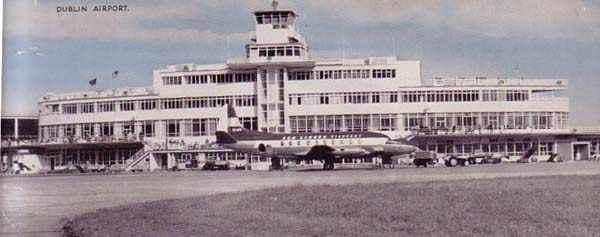
Long thin airport cards are not unknown but as single cards. Among 1950’s so-called panoramic cards there exist cards of Heathrow and this Dennis issue card of Dublin. Like most unusual size cards this one has taken some battering, although not postally used, which highlights the storage problems which make such cards unpopular with collectors. Unlike many large card subjects however I am not aware that this particular Dublin view exists in other sizes. The other oddity is that it is part-tinted – a blue sky but no attempt, thankfully green either the grass or the Viscount.
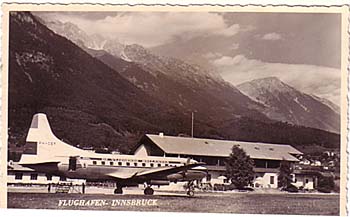
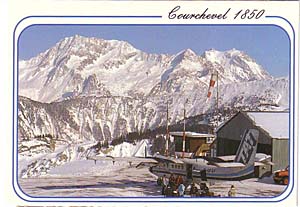
THE B-17 BEFORE AND AFTER
What relatively few B-17 cards there are, are concentrated in the period before the outbreak of WW2 and afterwards, including some of the many preserved examples as well as retrospective WW2 views. The following cards illustrate the B-17B and B-17C. The Black & White line up of B-17B’s is an Army recruiting card with back text Defend Your Country – Join the US Army, while the linen style colour B-17C back text refers to a non-stop 300 mile flight from Panama to Chile.
Where a manufacturer develops a range of aircraft it is often easy to see some distinguishing feature which links the various models – the deHavilland tail springs to mind as does the Boeing 707/727/737 nose design. It is less clear when the basic design is developed by different designers in different companies. This was the case however in the development of the mid-forties Miles Aerovan into the SD-330 and SD-360 commuter turboprops from Shorts of Belfast, known as “Sheds” from their box shaped bodies. The “missing link” where the clue is in the name, was the Short Skyvan.
The Miles Aerovan was developed by Miles Aircraft at Woodley, Reading in the mid forties for an expected post-war market for a small freighter capable of carrying a ton of freight, 8 passengers or one motor car. It had a rear loading door under a tail boom. This feature may have been significant a winning sales for over 50 aircraft despite the competition from surplus Ansons and Oxfords.
A four engine development, the Merchantman had the same feature but was not proceeded with, probably due to the rear door being less of an advantage against surplus DC-3s.The same factor also inhibited the development of the more radical four-engined M.68 “Boxcar” which could fly with or without a detachable centre fuselage section which could be fitted with road wheels – basically an attempt at an aerial equivalent of the road tractor/trailer combination.
The Caravan was not built but Miles had sounded out Shorts of Belfast as a production partner and Shorts became sufficiently interested to buy the design and the HDM.105 trials data. Shorts however also recognised the basic design fault – that a small airliner/freighter for use on small undeveloped airfields with basic hangars should not have a wing-span usually found on much larger aircraft.
From the Skyvan, Shorts developed the larger SD-330 and SD-360 designed for the start for short-haul passenger operations. The 30 seat 330 first flew in 1974 and the 36 seat 360 in 1981. Both benefited from the growth in commuter airlines feeding into hub-and-spoke operations in the USA and both first entered service with such carriers, Command Airways of Poughkeepside, NY and Suburban Airlines of Pennsylvania respectively. The 330 tended to be ordered by small companies which then became associated with the majors, while, by the time the 360 was launched the fleets carried the markings of the big companies, American Eagle, United and US Air being among them. Both the 330 and 360 were in service at the time of boom in airline hobby publisher postcards in the 80s/90s and are strongly represented. The SD330 was the most numerous version with over 200 produced although this includes a number of the USAF cargo version C-23.
In the UK Loganair used both types, with the 360 latterly in BA franchise colours. Both were also used by British Midland and their Manx associate and Jersey European. The 330 carried British Caledonian colours when operated by associate Metropolitan. Other operators included Guernsey Airways, Air Ecosse, Gill Air, Genair and Eastern Airways. Aer Lingus operated the 360, one of which featured on a card by J/V of a non-fatal crash in the Midlands while engaged in a mail flight .
Airline issue cards of the 330 are known from Germany (DLT), Sweden (Flying Enterprise) and the USA (Air North, Colgan, Command, Golden West) and for the 360 from UK (Aurigny, Capital, Guernsey, Jersey European, Loganair, Manx, Titan), Denmark (Air Business, Muk-Air) Germany (Rheinland AS) Ireland (Aer Lingus) Sweden (Avia, Flying Enterprise, Holmstroem Air) and Turkey (Sonmez). The Sonmez is probably the rarest.
Many other operators feature on hobby-publisher cards but few SD330/360 were prominent on commercial airport cards with the exception being a 330 of Allegheny Commuter at Chautauqua County, Jamestown, NY as shown.
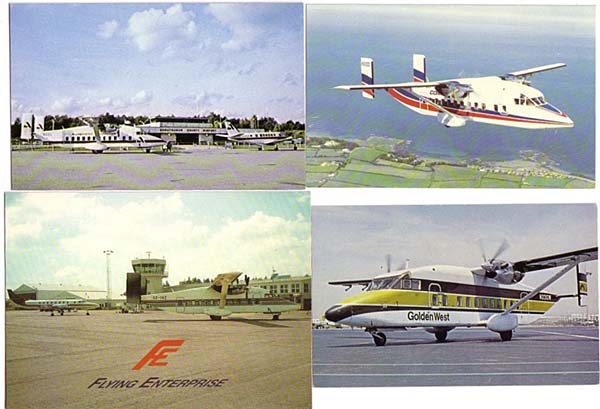
SD330 cards. Top : Alleghenny Commuter SD-330 at Jamestown NY, Launch customer Command Airways Bottom :- Swedish Carrier Flying Enterprise & California commuter Goilden West
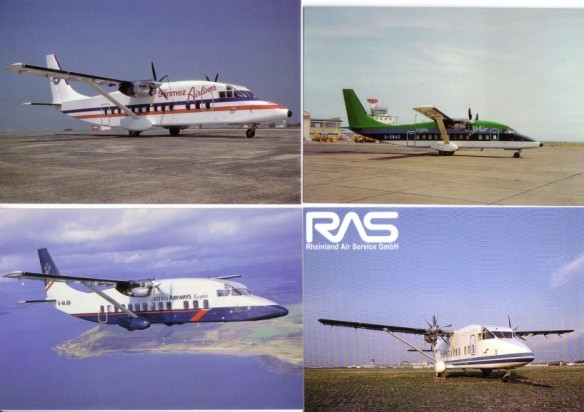
SD360 cards Top Both in colours of former owners – Gill Air Ex Aer Lingus 360 at Ronaldsway, Turkish Somnez Ex American airline-issue Bottom : Rhineland Air Services RAS airline issue at Dusseldorf, Loganair BA livery
|
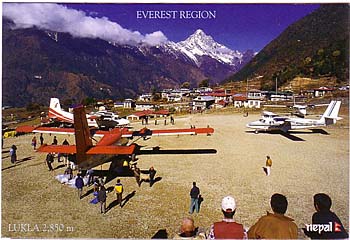 The other feature of the Pakistan card is that it shows a mountainous background not likely to encourage the nervous passenger. In the case of other Himalayan airports like the Nepalese sites Lukla featured here this would probably not be a deterrent to the type of visitor expected. The same is probably true of French ski resort Courcheval which also features a Twin Otter. First-time-flyers to Innsbruck, Austria in 1958 may have been more wary – the back message, sent to a vicar Lancashire says "…flight was very bumpy at the end. The luggage has gone astray……" KLM CV-240.
The other feature of the Pakistan card is that it shows a mountainous background not likely to encourage the nervous passenger. In the case of other Himalayan airports like the Nepalese sites Lukla featured here this would probably not be a deterrent to the type of visitor expected. The same is probably true of French ski resort Courcheval which also features a Twin Otter. First-time-flyers to Innsbruck, Austria in 1958 may have been more wary – the back message, sent to a vicar Lancashire says "…flight was very bumpy at the end. The luggage has gone astray……" KLM CV-240.
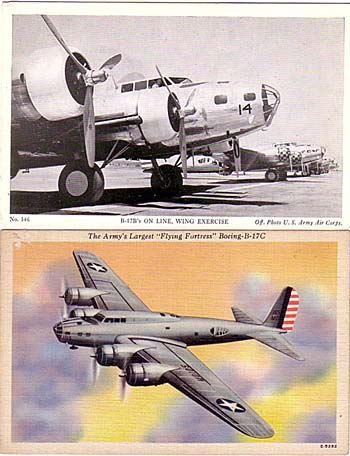 Whereas the “Giants” article featured the Boeing XB-15 it was the smaller B-17 that was to go into production. It quickly acquired the name Flying Fortress due to the number of its gun positions but the early models were actually lightly armed compared with the later WW2 models. Although the B-17 is synonymous with the UK based operations of the USAAF 8th Air Force, there is hardly a single card documenting this period – the most authentic seems to be that featured in “Worth a Second Glance” issued by the American Red cross.
Whereas the “Giants” article featured the Boeing XB-15 it was the smaller B-17 that was to go into production. It quickly acquired the name Flying Fortress due to the number of its gun positions but the early models were actually lightly armed compared with the later WW2 models. Although the B-17 is synonymous with the UK based operations of the USAAF 8th Air Force, there is hardly a single card documenting this period – the most authentic seems to be that featured in “Worth a Second Glance” issued by the American Red cross.
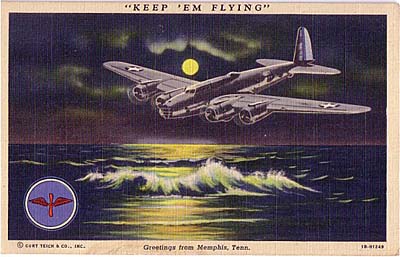 Both the previous cards show the pre-hostilities colour scheme with striped rudder. At this time the Star insignia also had a red centre. All traces of red were removed from USAAF and Navy insignia so that any red insignia could be assumed to be Japanese. The following card in the Keep Em Flying series shows a B-17C in the new drab colour scheme + the air corps insignia. This linen style card is by Curteich of Chicago, distributed by Bluff City News, Memphis, Tennessee with Greetings from Memphis added at the bottom
Both the previous cards show the pre-hostilities colour scheme with striped rudder. At this time the Star insignia also had a red centre. All traces of red were removed from USAAF and Navy insignia so that any red insignia could be assumed to be Japanese. The following card in the Keep Em Flying series shows a B-17C in the new drab colour scheme + the air corps insignia. This linen style card is by Curteich of Chicago, distributed by Bluff City News, Memphis, Tennessee with Greetings from Memphis added at the bottom
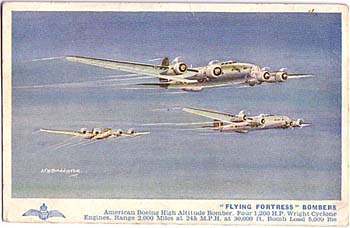 A few B-17C were supplied to the RAF who found them under-armed. They were however among the types featured by artist A F D Bannister in his series for J Salmon Ltd – this is No 4879.
A few B-17C were supplied to the RAF who found them under-armed. They were however among the types featured by artist A F D Bannister in his series for J Salmon Ltd – this is No 4879.
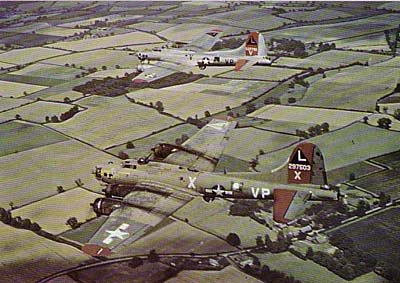 Next, three post WW2 cards. The effectiveness of the drab camouflage is shown in the retrospective “After the Battle” series card of B-17G Fortresses – with the added chin turret against head-on attacks. These are from 381 bomb group, Ridgewell Essex. However camouflage was not really relevant to high altitude daylight bombing and was discontinued , as on the background B-17.
Next, three post WW2 cards. The effectiveness of the drab camouflage is shown in the retrospective “After the Battle” series card of B-17G Fortresses – with the added chin turret against head-on attacks. These are from 381 bomb group, Ridgewell Essex. However camouflage was not really relevant to high altitude daylight bombing and was discontinued , as on the background B-17.
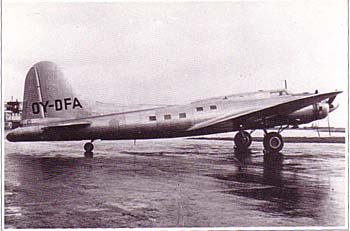 5 8th Air Force B-17s, out of many that landed in Sweden, were converted to 15 seat transports by SAAB for use on the Sweden-London service of ABA and to survey transatlantic service. One, re-registered in Denmark featured in a SAS history set.
5 8th Air Force B-17s, out of many that landed in Sweden, were converted to 15 seat transports by SAAB for use on the Sweden-London service of ABA and to survey transatlantic service. One, re-registered in Denmark featured in a SAS history set.
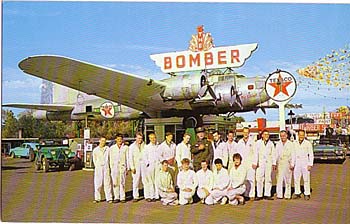 Most B-17s went to desert scrap yards and cards exist of these. One had a longer life as a motif for a filling station on Highway 99E in Milwaukie, Oregon (Not Wisconsin) who issued this card of the B-17 and its new crew
Most B-17s went to desert scrap yards and cards exist of these. One had a longer life as a motif for a filling station on Highway 99E in Milwaukie, Oregon (Not Wisconsin) who issued this card of the B-17 and its new crew
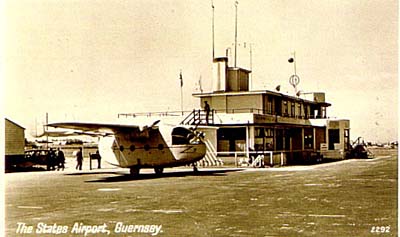 The Aerovan had a short service life even though 54 were built and only one seems to have been a main postcard subject. G-AILF of Pickfords at Guernsey Airport.
The Aerovan had a short service life even though 54 were built and only one seems to have been a main postcard subject. G-AILF of Pickfords at Guernsey Airport.
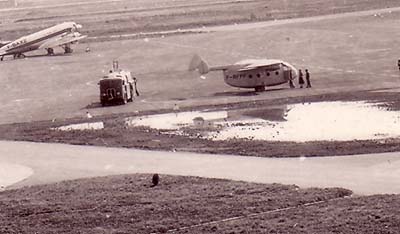 The only other known is this one vastly enlarged from an Algiers airport card. It can just be identified as F-BFPF previously with Ulster Aviation at Newtownards
The only other known is this one vastly enlarged from an Algiers airport card. It can just be identified as F-BFPF previously with Ulster Aviation at Newtownards
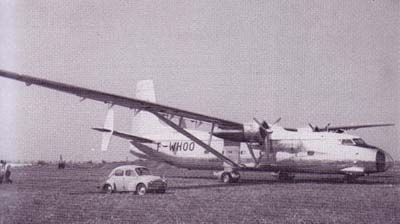 The original Miles company collapsed by 1950 but its successor company developed a version of the Aerovan using a high aspect ration (very long, very thin) wing developed by French engineer Maurice Hurel. The only production type to feature the Hurel wing was the Hurel Dubois HD-34 specialist survey aircraft. The French Institute Geographique National (IGN) took eight to supplement their fleet of survey B-17 Fortresses. This one, IGN F-WHOO, is not a postcard but there may be one of the twin-finned prototype in the Ailes B set of Black & White retrospective cards.
The original Miles company collapsed by 1950 but its successor company developed a version of the Aerovan using a high aspect ration (very long, very thin) wing developed by French engineer Maurice Hurel. The only production type to feature the Hurel wing was the Hurel Dubois HD-34 specialist survey aircraft. The French Institute Geographique National (IGN) took eight to supplement their fleet of survey B-17 Fortresses. This one, IGN F-WHOO, is not a postcard but there may be one of the twin-finned prototype in the Ailes B set of Black & White retrospective cards.
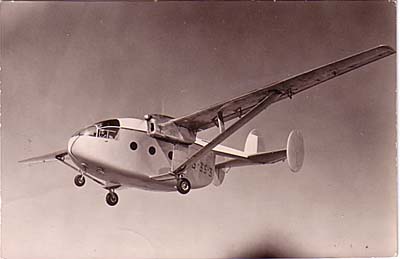 The HDM-105 was intended as a test vehicle for a larger airliner to be known as the HDM.106 Caravan and was numbered HDM.105. It later an early use of “fixed” markings taking over G-AHDM from a Halifax. The card is by Dutch publisher Aerohobby.
The HDM-105 was intended as a test vehicle for a larger airliner to be known as the HDM.106 Caravan and was numbered HDM.105. It later an early use of “fixed” markings taking over G-AHDM from a Halifax. The card is by Dutch publisher Aerohobby.
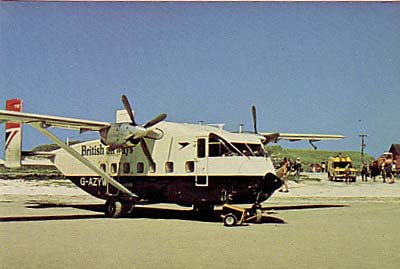 The subsequent re-design with a less radical, but still quite thin, wing was basically a box with a plank on top. The Short Skyvan, was designed for 15 passengers or 3000 lbs of freight. Construction commenced in 1960 but the Skyvan did not fly until 1963 due to competition from Short Belfast production. By then it was obvious that the piston engined prototype should be re-engined with turboprops. Production totalled about 150, mostly for overseas including military orders for Argentina, Austria, Indonesia, Ecuador, Gulf States, Mexico and Ecuador. The USA, Canada and Australia took the bulk of export orders. BEA and Loganair used the Skyvan on Scottish services including the island routes, as on the Barra card shown.
The subsequent re-design with a less radical, but still quite thin, wing was basically a box with a plank on top. The Short Skyvan, was designed for 15 passengers or 3000 lbs of freight. Construction commenced in 1960 but the Skyvan did not fly until 1963 due to competition from Short Belfast production. By then it was obvious that the piston engined prototype should be re-engined with turboprops. Production totalled about 150, mostly for overseas including military orders for Argentina, Austria, Indonesia, Ecuador, Gulf States, Mexico and Ecuador. The USA, Canada and Australia took the bulk of export orders. BEA and Loganair used the Skyvan on Scottish services including the island routes, as on the Barra card shown.
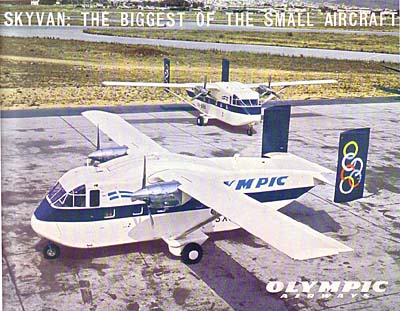 Also on island services were three for Greek carrier Olympic, as per the large card illustrated. Two airline issues are known, the large size Olympic card shown and one from Danish Air Transport. Like the Aerovan at Algiers, a Skyvan can also be detected on a 1995 Oulu airport, Finland card. One was registered in Finland at that time so the balance of probability makes it OH-SBA and the resultion is just about good enough to take magnification.
Also on island services were three for Greek carrier Olympic, as per the large card illustrated. Two airline issues are known, the large size Olympic card shown and one from Danish Air Transport. Like the Aerovan at Algiers, a Skyvan can also be detected on a 1995 Oulu airport, Finland card. One was registered in Finland at that time so the balance of probability makes it OH-SBA and the resultion is just about good enough to take magnification.
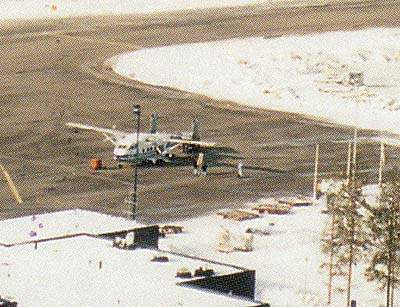 There is also a presumed Finnish Skyvan on an Oalu Airport card from 1995.
There is also a presumed Finnish Skyvan on an Oalu Airport card from 1995.